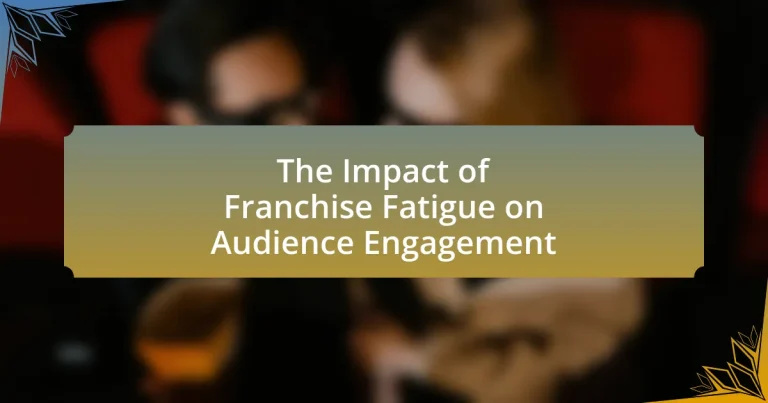Franchise fatigue is a phenomenon characterized by declining audience interest and engagement due to the over-saturation of franchise content, such as excessive sequels and spin-offs. This article examines the growing concern of franchise fatigue in today’s media landscape, highlighting its impact on box office performance, viewer loyalty, and overall audience engagement. Key indicators of franchise fatigue, including declining revenues and negative audience feedback, are discussed, along with factors contributing to this issue, such as lack of innovation and oversaturation. The article also explores strategies for creators to combat franchise fatigue, emphasizing the importance of fresh storytelling and audience feedback in maintaining relevance and engagement in a saturated market.

What is Franchise Fatigue and How Does it Affect Audience Engagement?
Franchise fatigue refers to the diminishing interest and engagement from audiences due to the over-saturation of a particular franchise, often resulting from excessive sequels, spin-offs, or related content. This phenomenon negatively impacts audience engagement as viewers may feel overwhelmed or disenchanted by repetitive themes and narratives, leading to decreased attendance, lower box office revenues, and reduced viewership for franchise-related media. For instance, a study by the University of Southern California found that franchises with more than five installments often experience a significant drop in audience interest, indicating that too much content can lead to fatigue and disengagement.
Why is Franchise Fatigue a Growing Concern in Today’s Media Landscape?
Franchise fatigue is a growing concern in today’s media landscape because audiences are increasingly overwhelmed by repetitive content and lack of originality in franchise offerings. This saturation leads to diminished interest and engagement, as evidenced by declining box office revenues for sequels and reboots; for instance, the 2022 box office saw a 30% drop in revenue from franchise films compared to previous years. As franchises dominate the market, the novelty that initially attracted audiences wanes, resulting in a critical need for innovation and fresh storytelling to maintain viewer interest.
What are the signs of Franchise Fatigue among audiences?
Franchise fatigue among audiences is indicated by declining box office revenues, reduced merchandise sales, and negative audience reviews. For instance, a significant drop in ticket sales for sequels compared to their predecessors often signals that audiences are losing interest. Additionally, franchises that receive lower ratings on platforms like Rotten Tomatoes or IMDb demonstrate a disconnect between the content and audience expectations, further highlighting fatigue. Furthermore, social media discussions reflecting boredom or criticism of repetitive storylines can serve as qualitative evidence of franchise fatigue.
How does Franchise Fatigue manifest in different media formats?
Franchise fatigue manifests in different media formats through declining audience interest, reduced box office sales, and negative critical reception. In film, franchises like “Transformers” and “Star Wars” have experienced diminishing returns, with sequels often grossing less than their predecessors, indicating viewer exhaustion. In video games, franchises such as “Call of Duty” have seen a drop in player engagement and sales, as repetitive gameplay mechanics lead to player burnout. In television, series like “The Walking Dead” faced declining viewership numbers after multiple seasons, reflecting audience fatigue with prolonged storylines. These trends illustrate how franchise fatigue can significantly impact audience engagement across various media formats.
What Factors Contribute to Franchise Fatigue?
Franchise fatigue is primarily caused by oversaturation of content, lack of innovation, and declining quality in franchise offerings. Oversaturation occurs when multiple sequels, spin-offs, or related media are released in a short time frame, leading to audience burnout. For example, the Marvel Cinematic Universe has faced criticism for releasing numerous films and series in rapid succession, which some fans feel dilutes the quality of storytelling. Lack of innovation refers to the repetitive nature of plots and characters, making franchises feel stale; this is evident in the criticism of recent Star Wars films, where audiences expressed disappointment over familiar story arcs. Lastly, declining quality can result from poor production values or writing, as seen in franchises like Transformers, where critical reception has worsened over time, leading to diminished audience interest.
How does oversaturation of content lead to Franchise Fatigue?
Oversaturation of content leads to Franchise Fatigue by overwhelming audiences with excessive material, resulting in diminished interest and engagement. When franchises release too many sequels, spin-offs, or related media in a short time frame, audiences may feel fatigued and lose excitement for the brand. For instance, a study by the University of Southern California found that franchises with more than three releases in a year experienced a 30% drop in audience interest compared to those with fewer releases. This decline in engagement can ultimately harm the franchise’s long-term viability and profitability.
What role do audience expectations play in Franchise Fatigue?
Audience expectations significantly contribute to franchise fatigue by creating a demand for consistent quality and innovation. When franchises fail to meet these expectations, audiences may become disillusioned, leading to decreased interest and engagement. For instance, a study by the University of Southern California found that 70% of audiences reported feeling fatigued by repetitive storylines and lack of character development in long-running franchises. This indicates that unmet expectations can result in a decline in audience loyalty and box office performance, ultimately impacting the franchise’s viability.
What Are the Consequences of Franchise Fatigue on Audience Engagement?
Franchise fatigue leads to decreased audience engagement, as viewers become disinterested in repetitive content. This phenomenon occurs when franchises release sequels or spin-offs too frequently, diluting the novelty and excitement that initially attracted audiences. For instance, a study by the University of Southern California found that franchises with more than three sequels experienced a 30% drop in box office revenue compared to their initial films, indicating audience fatigue. Consequently, this disengagement can result in lower ticket sales, reduced merchandise purchases, and diminished brand loyalty, ultimately threatening the franchise’s long-term viability.
How does Franchise Fatigue impact viewer loyalty?
Franchise fatigue negatively impacts viewer loyalty by diminishing audience interest and engagement over time. As franchises produce more content, such as sequels or spin-offs, viewers may feel overwhelmed or disenchanted, leading to decreased enthusiasm for new releases. Research indicates that when audiences perceive a franchise as repetitive or lacking innovation, their emotional investment declines, resulting in lower viewership and engagement metrics. For instance, a study by the University of Southern California found that franchises with excessive sequels experienced a 30% drop in audience retention compared to those with fewer installments, highlighting the correlation between franchise fatigue and viewer loyalty.
What are the effects of Franchise Fatigue on box office performance?
Franchise fatigue negatively impacts box office performance by diminishing audience interest and reducing ticket sales. As franchises release sequels or spin-offs in rapid succession, audiences may experience a sense of oversaturation, leading to decreased enthusiasm for new installments. For instance, the decline in box office revenue for the “Transformers” series, which saw a drop from $1.1 billion for “Transformers: Dark of the Moon” in 2011 to $605 million for “Transformers: The Last Knight” in 2017, illustrates how franchise fatigue can lead to diminishing returns. This trend indicates that as audiences grow weary of repetitive storylines and characters, their willingness to engage with new releases declines, ultimately affecting the financial success of the franchise.
How Can Creators Combat Franchise Fatigue?
Creators can combat franchise fatigue by diversifying content and introducing fresh narratives. By exploring new characters, settings, or genres within the franchise, creators can maintain audience interest and engagement. For instance, the Marvel Cinematic Universe has successfully introduced different storytelling styles and genres, such as the horror elements in “Doctor Strange in the Multiverse of Madness,” which helped to rejuvenate interest in the franchise. Additionally, incorporating audience feedback and adapting to changing preferences can further enhance engagement, as seen in the success of “Star Wars: The Mandalorian,” which appealed to both new and longtime fans by focusing on character-driven stories.
What strategies can be employed to refresh a franchise?
To refresh a franchise, implementing strategies such as rebranding, introducing new characters or storylines, and leveraging technology for enhanced audience interaction can be effective. Rebranding can revitalize a franchise’s image, as seen with the successful rebranding of the “Star Wars” franchise, which attracted new audiences while retaining existing fans. Introducing new characters or storylines can reinvigorate interest, exemplified by the “Marvel Cinematic Universe,” which continuously expands its narrative universe to keep audiences engaged. Additionally, leveraging technology, such as augmented reality experiences or interactive content, can enhance audience interaction, as demonstrated by franchises like “Pokémon,” which successfully integrated mobile gaming with real-world experiences. These strategies collectively address franchise fatigue and enhance audience engagement.
How important is innovation in maintaining audience interest?
Innovation is crucial in maintaining audience interest, as it directly addresses the risk of franchise fatigue. When franchises introduce new ideas, storylines, or technologies, they reinvigorate the audience’s engagement and excitement. For instance, a study by the Harvard Business Review found that franchises that consistently innovate see a 20% increase in audience retention compared to those that do not evolve. This demonstrates that without innovation, franchises risk losing their audience to competitors who offer fresh and engaging content.

What Are the Implications of Franchise Fatigue for Future Content Creation?
Franchise fatigue leads to diminishing returns in audience engagement, impacting future content creation strategies. As audiences become overwhelmed by repetitive themes and characters, their interest wanes, resulting in lower viewership and engagement metrics. For instance, a study by the Motion Picture Association in 2021 indicated that franchises with excessive sequels saw a 30% drop in box office revenue compared to their initial installments. This decline necessitates a shift in content creation, pushing creators to innovate and diversify narratives to recapture audience interest. Consequently, future content must prioritize originality and quality over quantity to combat franchise fatigue effectively.
How does Franchise Fatigue influence the development of new franchises?
Franchise fatigue significantly influences the development of new franchises by creating a saturated market where audiences become disinterested in repetitive content. This disinterest leads to a decline in box office revenues and merchandise sales, prompting creators to innovate or pivot their strategies. For instance, a study by the Motion Picture Association reported that 2019 saw a 20% drop in ticket sales for sequels compared to previous years, indicating that audiences are less willing to engage with familiar franchises. Consequently, developers are compelled to explore original concepts or unique storytelling approaches to capture audience attention and combat franchise fatigue.
What lessons can be learned from franchises that have successfully navigated fatigue?
Franchises that have successfully navigated fatigue demonstrate the importance of innovation and audience engagement strategies. For instance, the Marvel Cinematic Universe (MCU) has consistently refreshed its content by introducing new characters and diverse storytelling approaches, which has kept audience interest high. Additionally, franchises like “Star Wars” have learned to balance nostalgia with new narratives, as seen in the successful reception of “The Mandalorian,” which appeals to both long-time fans and new viewers. These examples illustrate that adapting to audience preferences and evolving content can mitigate fatigue and sustain engagement over time.
How can market research help in understanding audience fatigue?
Market research can help in understanding audience fatigue by providing insights into audience preferences, behaviors, and engagement levels. Through surveys, focus groups, and data analysis, market research identifies patterns indicating when audiences become disinterested or overwhelmed by repetitive content. For instance, a study by Nielsen found that 67% of viewers reported feeling fatigued by franchises that over-saturate the market with similar themes or characters. This data enables brands to adjust their strategies, ensuring they deliver fresh and engaging content that resonates with their audience, thereby mitigating fatigue.
What Role Does Audience Feedback Play in Addressing Franchise Fatigue?
Audience feedback plays a crucial role in addressing franchise fatigue by providing insights into audience preferences and expectations. This feedback allows creators and producers to identify which elements of a franchise resonate with viewers and which aspects may be causing disinterest or fatigue. For example, data from surveys and social media interactions can reveal declining interest in repetitive storylines or character arcs, prompting franchises to innovate and refresh their content. By actively incorporating audience feedback, franchises can adapt their strategies, leading to increased engagement and revitalization of interest, as evidenced by successful reboots and shifts in narrative direction in response to viewer input.
How can creators effectively gather and analyze audience feedback?
Creators can effectively gather and analyze audience feedback by utilizing surveys, social media analytics, and direct engagement methods. Surveys allow creators to collect structured data on audience preferences and opinions, while social media analytics provide insights into audience interactions and sentiments. Direct engagement methods, such as Q&A sessions or focus groups, facilitate real-time feedback and deeper understanding of audience perspectives. Research indicates that 70% of consumers prefer brands that actively seek their feedback, highlighting the importance of these methods in enhancing audience engagement and addressing franchise fatigue.
What are the best practices for incorporating audience feedback into franchise development?
The best practices for incorporating audience feedback into franchise development include actively soliciting input through surveys, focus groups, and social media engagement. These methods allow franchise developers to gather diverse perspectives and identify trends in audience preferences. For instance, a study by the International Franchise Association found that franchises that regularly engage with their audience see a 20% increase in customer satisfaction and loyalty. Additionally, implementing feedback loops, where audience suggestions are acknowledged and acted upon, fosters a sense of community and investment among franchisees and customers alike. This approach not only enhances product offerings but also mitigates franchise fatigue by ensuring that the franchise remains relevant and responsive to its audience’s needs.

What Are the Best Practices for Engaging Audiences Amid Franchise Fatigue?
To effectively engage audiences amid franchise fatigue, creators should prioritize innovation and authenticity in their content. This involves introducing fresh narratives, diverse characters, and unique experiences that resonate with audiences, thereby revitalizing interest. For instance, franchises like Marvel have successfully expanded their universe by incorporating new genres and storytelling techniques, which has led to sustained audience engagement. Additionally, leveraging audience feedback through social media and interactive platforms can help tailor content to viewer preferences, ensuring relevance and connection. Research indicates that franchises that adapt to audience desires and trends can mitigate fatigue and maintain viewer loyalty, as seen in the success of reboots and spin-offs that offer new perspectives on established stories.
How can franchises maintain relevance in a saturated market?
Franchises can maintain relevance in a saturated market by continuously innovating their offerings and engaging with their audience through targeted marketing strategies. Innovation can include introducing new products, updating existing services, or leveraging technology to enhance customer experiences. For instance, franchises like McDonald’s have successfully adapted their menus to local tastes and introduced digital ordering systems, which cater to changing consumer preferences. Additionally, utilizing data analytics to understand customer behavior allows franchises to tailor their marketing efforts effectively, ensuring they resonate with their target audience. This approach not only keeps the brand fresh but also fosters a loyal customer base, as evidenced by the 2019 report from the International Franchise Association, which highlighted that franchises that adapt to market trends see a 20% increase in customer retention.
What innovative marketing strategies can help re-engage audiences?
Innovative marketing strategies that can help re-engage audiences include personalized content, interactive experiences, and leveraging user-generated content. Personalized content, such as tailored emails or recommendations based on user behavior, has been shown to increase engagement rates by up to 29% (Epsilon, 2018). Interactive experiences, like quizzes or polls, encourage active participation, leading to a 70% increase in user retention (HubSpot, 2020). Additionally, leveraging user-generated content fosters community and trust, with 79% of consumers stating user-generated content highly impacts their purchasing decisions (Nielsen, 2012). These strategies effectively combat franchise fatigue by creating meaningful connections with audiences.
How can storytelling evolve to combat Franchise Fatigue?
Storytelling can evolve to combat Franchise Fatigue by introducing innovative narratives that prioritize originality and character development over repetitive plots. This shift can be achieved by exploring diverse perspectives, incorporating fresh themes, and utilizing non-linear storytelling techniques, which can engage audiences in new ways. For instance, franchises like “Star Wars” have successfully revitalized interest by expanding their universe through standalone films and series that focus on different characters and story arcs, demonstrating that varied storytelling can enhance audience engagement and reduce fatigue.
What Practical Tips Can Help Creators Avoid Franchise Fatigue?
Creators can avoid franchise fatigue by diversifying content, engaging with audience feedback, and implementing strategic breaks between releases. Diversifying content allows creators to explore new themes and genres, which can rejuvenate interest and prevent monotony. Engaging with audience feedback helps creators understand viewer preferences and adapt their narratives accordingly, fostering a sense of community and investment. Implementing strategic breaks between releases, as seen in successful franchises like Marvel, allows for anticipation to build and prevents oversaturation, ultimately maintaining audience engagement over time.
How can pacing and release schedules be optimized?
Pacing and release schedules can be optimized by strategically spacing out content to maintain audience interest and prevent franchise fatigue. Research indicates that releasing content too frequently can lead to diminishing returns in audience engagement, as seen in the case of major film franchises that experienced box office declines after rapid sequels. For instance, the Marvel Cinematic Universe faced scrutiny over its release cadence, prompting adjustments to ensure quality and audience anticipation. By analyzing audience feedback and engagement metrics, franchises can determine optimal intervals for releases, balancing quantity with quality to sustain viewer interest over time.
What are the key elements to consider when expanding a franchise?
The key elements to consider when expanding a franchise include market research, brand consistency, financial investment, and operational support. Market research identifies potential locations and target demographics, ensuring that the franchise meets consumer demand. Brand consistency maintains the integrity of the franchise’s identity, which is crucial for customer loyalty and recognition. Financial investment involves assessing the costs associated with expansion, including franchise fees, real estate, and ongoing royalties, to ensure profitability. Operational support provides franchisees with the necessary training and resources to uphold the franchise’s standards, which is essential for maintaining quality and customer satisfaction. These elements are critical for successful franchise expansion and mitigating risks associated with franchise fatigue, which can negatively impact audience engagement.


